Why is warehouse efficiency so important? Can materials handling equipment help achieve efficiency in your warehouse operation? Melissa Barnett looks at what is on offer in this two-part feature on achieving optimal warehouse efficiency.
Warehouse operations are becoming faster, more complex and, by necessity, more efficient. Why? "Because efficient warehouse operations are key in today's competitive environment," says Hans Seijger, vice president, sales and marketing for Cat Lift Trucks.
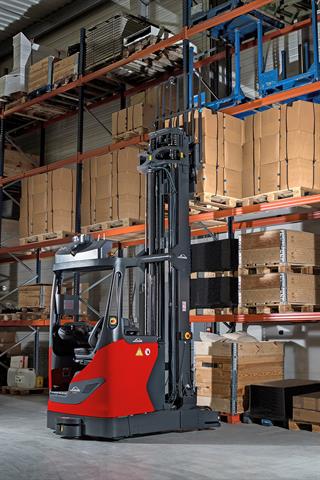 The autonomous Linde R-MATIC |
There are a number of factors that make warehouse efficiency a challenging goal, including the cost of floor space, idle equipment, increasing labour costs and poorly designed storage layout. Overall, warehouses create significant cost in the value chain. Stocked goods increase working capital and transport and stacking do not add value to the product, points out Georg Kranefeld, senior director of product management industrial trucks at Linde Materials Handling. "Only picking is a value-generating application in a warehouse. Therefore, the most effective contribution warehousing can do for company results is minimising cost by maximising the efficiency," he adds.
If picking is the only activity that can generate value in a warehouse, then it makes sense to look carefully for warehouse equipment and any accessories that will enhance the operation, particularly when warehouse logistics are dealing with shorter handling cycles and smaller loads that demand a different management of goods. When looking for equipment, it is important that the equipment responds to a range of expectations, which should include design as well as function. Equipment which is developed to respond to a customer's needs in terms of operator health, ergonomics and safety, and that offers a reduction in energy consumption, increases productivity and reduces disruption in the business.
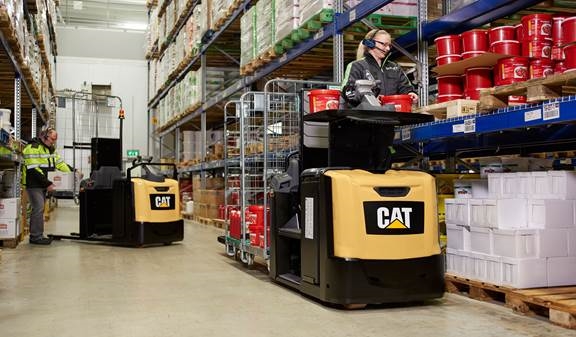 Cat warehouse equipment |
Seijger believes that one of the most important assets in a warehouse is the operator, because when your people are working efficiently, the whole business works efficiently. "With our products, we want to deliver the best user experience possible so the warehouse operators have a comfortable and safe space to work in," he says. "The Cat
® NO12 - 25N2 range of order pickers offers a wide and unobstructed walk-through for drivers and a concave middle area to give grip in curves. The platform is designed to reduce micro-vibration and help to minimise the strain in the foot, knees and ankles - something extremely important in long shifts. The steering wheel has vibration damping, and can be adjusted for height and angle to maximise comfort. The NO-N2 range's intelligent curve control reacts to operator steering behaviour and travel speed by adjusting sensitivity, cornering speed and angle limitation intuitively, reducing danger and damage," explains Seijger.
Time and space are costly, so it is essential to evaluate your warehouse layout and material flow, says Combilift CEO Martin McVicar, whose company offers a free warehouse design service. A good warehouse evaluation and design can identify not just wasted space but wasted time due to an inefficient layout. "In some cases, pickers can spend 65% of time in transit, picking for just 20% of the shift, with the rest being taken up by searching for stock or dead time. As the most expensive cost factor in any logistics set-up is driving time, this can be avoided by adopting ABC slotting - storing the most popular products closest to the picking line and the least popular items farthest away," says McVicar.
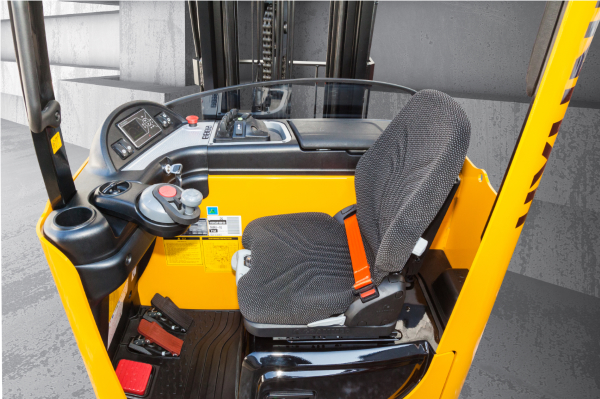 Hyundai 16BRJ-9 Reachtruck |
Nathan Owens, chief operating officer for Hyundai Materials Handling Australia, agrees and says a key factor to achieving efficiency is providing the warehouse with the correct materials handling equipment for the job they are performing. Site evaluations as well as understanding the site's goals play an important role as both can significantly affect the mix of equipment supplied. Owens says that Hyundai has been supplying equipment to two large 3PL organisations for the last two years. Over this time, one of the companies has reduced the cost of its operation by over AUD1 million (USD680,000) per annum and increased productivity, while the second company has achieved 100% uptime over 18 months. Owens believes this has been achieved by providing a holistic solution that addresses the number of materials handling equipment units required and providing alternative solutions to achieve operational goals.
Combilift specialises in developing materials handling equipment with the advantages of multiple functions in a single unit, able to offload outside, bring product directly to racking in the warehouse (truck to trailer operation) and work in the manufacturing area. McVicar says that the versatility of this sort of equipment ensures that each truck works effectively and at its best possible capacity. It also enables operations to reduce their forklift size which has multiple benefits, including reduced maintenance costs, lower insurance premiums, and fewer forklift operators which reduces operator training costs.
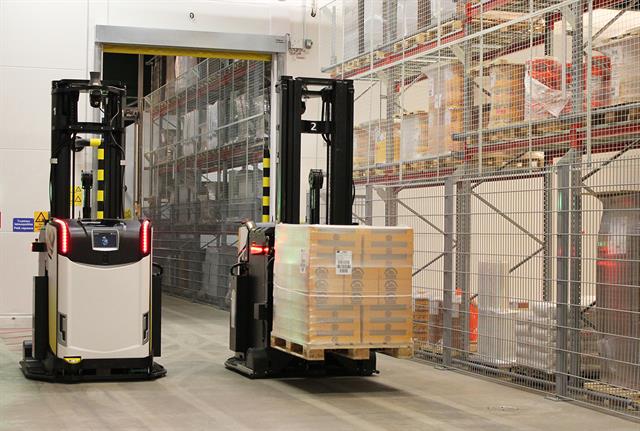 Rocla AGVs operate in areas where there are also manual forklifts and people |
When talking about rationalising equipment in the warehouse, the discussion inevitably turns to automated equipment. Niels Hanssen, sales director for Finnish manufacturer Rocla AGV Solutions, agrees that moving inventory is a major cost in every industry and the area which has the most potential to create efficiencies. "A fully integrated automation system will only deliver goods when needed to the right place at the right time. Undemanding tasks don't have to be executed by an operator, which enables the employee to do a more productive task, with the automated machine providing a high level of safety compared to a manual operated warehouse," says Hanssen. A decade ago, Rocla delivered 10 AGVs to Swedish polyethylene manufacturing company Borealis to solve the customer's need for more storage space in one location. During the decade of operation, the AGV system has been developed further and its technology updated. The latest tasks were to increase the out-feed speed and to increase the available storage space. To date, automation has increased transport efficiency by over 50% and the storage space has increased with 1,000 extra locations.
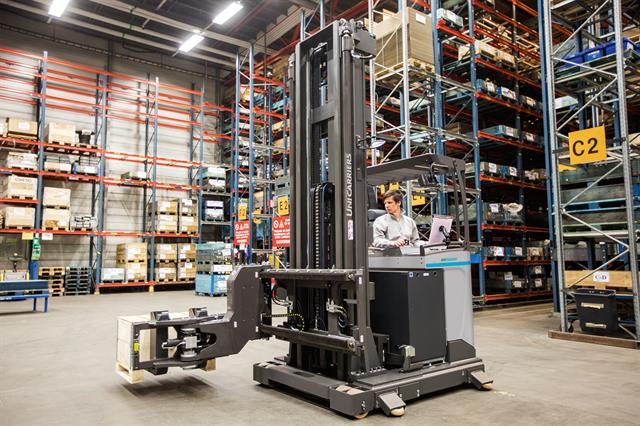 UniCarrier's very narrow aisle trucks |
Technological advances in the last few years in telematics and warehouse management systems have ensured that no matter what equipment you have operating in your warehouse, if well-managed, it should deliver you a better bottom line. Gary Hansen, chief operating officer of Capital Equipment & Handling, a factory-owned dealer of UniCarriers Americas, believes that if your operation doesn't have a good grasp of efficiency or a sound system in place, you're less likely to serve customers at a high level. One of UniCarriers' customers, a leading manufacturer of precision plastic parts for the automobile industry, uses UCATX35-M and TX40-M three-wheel electrics, fitted with fleet management systems that include daily operational checklists, impact management systems, scales and cameras. All the forklifts have an onboard computer system, utilising warehouse management systems (WMS) directing the operators to their task. "By fully integrating all these features, the company is able to efficiently move raw goods to production and finished goods to storage or shipment. Product is stored correctly and a high productivity is maintained, enabling the company to fill orders and move product out the door when needed, keeping costs low and customers happy," says Hansen.
Where to next?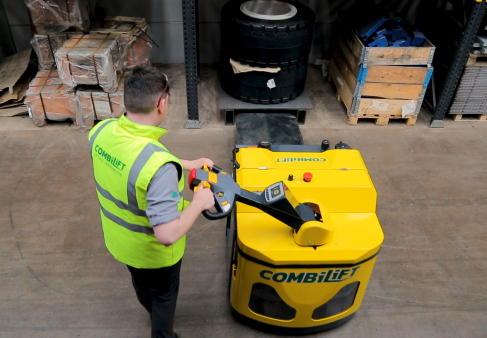 Combilift's two tiller arm overview |
Rapid change has occurred in many aspects of warehousing in the past 10 years - data, the Internet of Things, telematics, WMS and smaller, higher storage spaces, so what might the future bring to maintain an efficient warehouse? McVicar believes that pedestrian-operated forklifts which can be operated in the smallest available aisle width is a huge growth sector. Combilift already produces a narrow-aisle pedestrian pallet truck with an internationally patented multi-position tiller arm and the company aims to increase the load-carrying capacity of its range in the coming years. "Pedestrian-operated forklifts with capacities to carry up to 16,000kg can now be deployed for moving much heavier and bulky items around warehouses as well as production facilities," says McVicar.
Hanssen of Rocla AGV Solutions believes that operators do not want to spend their time on simple tasks anymore and this will only become more of an issue in the future, as the coming generation looks for more challenges in their lives. "In the future, the normal A to B transports will be increasingly handled by automated systems," he predicts.
UniCarriers has seen increased interest in narrow aisle equipment, automatic retrieval systems and self-driving equipment and is positioning the company with Rocla AGVs. " We believe this is the way of the future. It is a learning curve from the dealers' perspective, but they're catching on that you need to take advantage of automated equipment or you will be left behind," says Unicarriers' Hansen.
Automation will accelerate as employee salaries become the highest cost contributor and biggest planning uncertainty, predicts Kranefeld, but the biggest change will be in perspective: "The single product performance is no longer differentiating enough. Understanding and interpreting customer processes and having the technical ability to maximise the process so that it is fit for purpose will be the next big challenge," he says.
Hyundai's Owens says that in today's competitive market, the pressure on organisations to find new ways to innovate and deliver value is growing at an exponential pace. Quality, safety, efficiency, service and technology are the dominant themes at play in the warehouse market. "With the launch of our new range of Hyundai warehousing equipment, we have worked with customers to ensure we are delivering on their requirements whilst introducing some industry firsts focused on future-proofing our customers businesses," says Owens. These include Li-ion battery technology, more energy-efficient equipment, development of an Intelligent Proximity Awareness System (IPAS), autonomous unmanned forklifts controlled by a WMS, wireless charging, fuel cell technology and the in-house development of fleet management systems.
"When we talk about product development of the future, we need to consider that we are already in the future," says Seijger. "When designing our products, we are not only considering the present needs of our customers, but also anticipating future needs and trends - health, safety, energy productivity, less disruption and connectivity." He predicts that automation will progress, particularly towards highly efficient tailored automation solutions, with electric vehicle and battery technology continuing to evolve. "Cat products will keep offering features that help the operator improve their productivity in an ergonomically friendly environment, having as a result a better outcome for the company," he adds.
It seems that efficiency will continue to be key to any warehouse operation. There will always be the imperative to get the goods moving faster and at less cost through the warehouse and to the customer. The focus may move slightly from functional engineering to a more human-centric perspective - but efficiency remains the end goal.
Read part two of our Warehouse Efficiency feature here.Additional information and a special 'THANK YOU' to our contributors:Switch to Linde lifts warehouse performance for GMK Logistics
Linde Material Handling Australia: website------------------------------------
Prepare for the winter months: Our top 10 forklift safety tips
Mitsubishi Caterpillar Forklifts Europe (MCFE): website------------------------------------
Leading-edge polyolefin plastic materials by Borealis in Stenungsund, Sweden
Rocla Oy: website------------------------------------
Hyundai - Creating fans out of customers
Hyundai Material Handling Australia: website------------------------------------
Fall into Savings with UniCarriers Forklift
Unicarriers Americas Corporation: website------------------------------------
Combilift: website------------------------------------